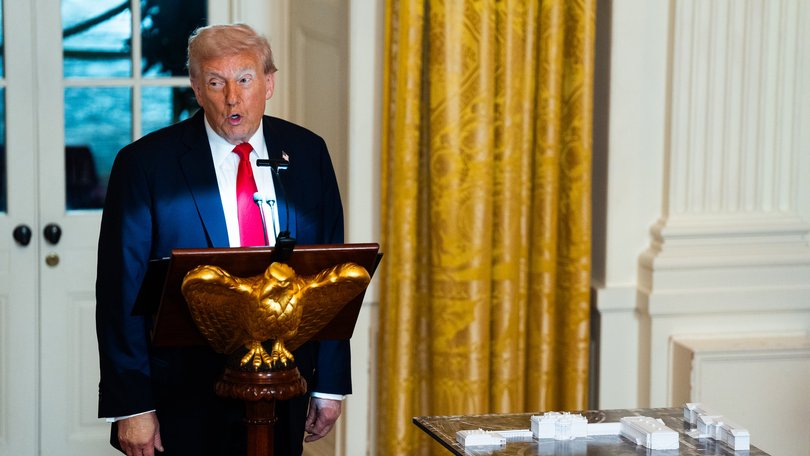How Donald Trump’s government shutdown breaks all the rules, rewrites the playbook on presidential power

With the government shut down, President Donald Trump and his administration have moved to lay off federal workers, cancelled projects in Democratic congressional districts and unilaterally ensured that programs he favours continue to operate.
Republican leaders in Congress have argued that it’s business as usual under a shutdown.
Asked whether he’s comfortable with the administration using the shutdown to lay off federal workers, Senate Majority Leader John Thune (R-South Dakota) said Wednesday: “I’m not comfortable with any of this being done, because as I’ve said, I don’t like government shutdowns.”
Sign up to The Nightly's newsletters.
Get the first look at the digital newspaper, curated daily stories and breaking headlines delivered to your inbox.
By continuing you agree to our Terms and Privacy Policy.But, he added, “These are decisions that are being forced on the administration by the Democrats voting repeatedly … to keep the government shut down. Any administration makes decisions in a shutdown - and I’ve been through a lot of them with Democrat presidents as well - they are going to prioritise the things that are important to them.”
The reality is a little more complicated. While the president does have sweeping powers under a government shutdown, budget experts said this president may be stretching the legal limits.
Here’s what you need to know:
What usually happens during a government shutdown?
Congress is in charge of passing spending bills that keep the government funded. The latest funding measure lapsed on October 1.
Democrats are demanding Republicans agree to extend subsidies for Affordable Care Act health plans, and Republicans refuse to negotiate on the policy while the government is closed.
During a typical shutdown, federal agencies determine which of their employees are essential to protect life and government property. Those workers continue to work without pay. All other workers are furloughed without pay. Once lawmakers pass a spending bill, federal workers receive back pay for the shutdown.
Programs that are funded through other sources - such as Social Security and Medicare, which are funded by payroll taxes and trust funds, and the US Postal Service, which is funded through fees - continue to operate.
How has Trump changed the federal workforce under the shutdown?
Mr Trump and White House budget director Russell Vought signalled from the start of the shutdown that they would begin laying off federal workers if Democrats did not agree to a funding measure. Mr Trump even posted an AI-generated video of Vought as the Grim Reaper.
On October 10, the administration announced more than 4,000 positions would be eliminated across eight federal agencies. A senior administration official indicated more layoffs would be coming.
“We’ve never had a proposal that, in the midst of a lapse of funding, the administration would propose a reduction in force,” said Bill Hoagland, senior vice president at the Bipartisan Policy Centre, a Washington think tank.
“This is unprecedented.”
The White House has suggested that furloughed federal employees aren’t entitled to retroactive pay once the shutdown ends, despite a 2019 law signed by Mr Trump that guarantees it.
Is laying off federal workers necessary to keep services running?
The administration has repeatedly argued that federal layoffs are necessary to keep the federal government running at all as the shutdown continues.
“We are going to have to lay some people off if the shutdown continues,” Vice President JD Vance said during a White House briefing earlier this month.
“We don’t like that. We don’t necessarily want to do it, but we’re going to do what we have to do to keep the American people’s essential services continuing to run.”
The size of the federal workforce does not impact the government’s ability to pay its bills during a shutdown because most federal employees are not being paid, and their salaries are fully funded by congressional appropriations once the government reopens.
And laying off workers does not make it easier to keep services running.
“In fact it seems contradictory,” Mr Hoagland said.
Federal employees are needed “to keep Social Security offices open to process applicants, to keep processing applicants for housing vouchers, to keep offices open to process services to farmers and ranchers” and more.
Can Trump lay off federal workers during a shutdown?
The answer is complicated.
Since Mr Trump took office, courts have generally held that the president has wide discretion to dismiss government workers, as long as the administration adheres to federal personnel law.
The Trump administration, though, has argued that the shutdown gives the president even more power to fire workers. That is not true.
In fact, the shutdown could legally make it more difficult. Federal employees who have been laid off can’t prepare to leave their jobs because the human resources staff that usually processes layoffs are also furloughed, a federal judge wrote in a ruling pausing the layoffs.
It is “far from normal for an administration to fire line-level civilian employees during a government shutdown as a way to punish the opposing political party,” the judge wrote.
The White House has signalled plans to appeal the decision.
Has Trump cut funding for ‘Democrat programs’?
Mr Trump has said the shutdown provides an “unprecedented opportunity” to lay off workers in programs he says Democrats favour and to eliminate projects in Democratic states and congressional districts.
Since the shutdown began, the administration has cancelled an estimated $27 billion ($A41 billion) in funding for projects in Democratic cities and congressional districts.
That includes $18 billion in frozen funds for infrastructure projects in New York; $7.6 billion in clean energy grants for projects in 16 states that voted for former Democratic presidential candidate Kamala Harris; and $2.1 billion for projects in heavily Democratic Chicago.
Democrats in Congress have derided the cuts as an intimidation tactic and say it won’t push them to reopen the government.
Is Mr Trump allowed to block blue state programs?
The Trump administration used some complex maneuvers to hold up these programs.
On the transportation projects, the administration said programs in New York and Chicago relied on diversity-based contracting requirements that the White House claims violate civil rights law.
That means they must undergo a mandatory review - but because of the shutdown, the employees who’d conduct that process have been furloughed.
The energy projects, though, are a different story. The Energy Department was already targeting the projects and had made its decision to rescind the funding before the shutdown, Energy Secretary Chris Wright said.
Shutdown politics merely guided the timing of the announcements. The White House wanted to give the appearance that Democrats were paying a price for their intransigence. But hundreds of projects in red districts are also imperilled. It just opted to wait to make those official. Wright said more announcements will come in the weeks ahead.
How are the troops getting paid?
Congress can pass legislation that would continue funding for specific programs or employees. During some previous shutdowns, they have acted to make sure active-duty military are paid. This time, Republican leadership declined to take up such legislation, arguing Democrats should reopen the whole government to pay the troops.
Then Mr Trump announced he would use $8 billion in “unobligated” Pentagon funds to pay military service members without Congress.
The administration has also moved to keep other programs funded unilaterally.
Homeland Security Secretary Kristi L Noem said the agency would continue paying more than 70,000 law enforcement officers, including in Customs and Border Protection, Immigrations and Customs Enforcement, the Secret Service and the Transportation Security Administration, but did not indicate where the money for salaries would come from.
She previously said funding for the Coast Guard would come from the Republican tax and spending law passed earlier this year, even though the measure does not allow funds to be used for purposes that aren’t outlined in the law. FBI Director Kash Patel said FBI agents would also be paid.
“We got the people that we want paid, paid,” Mr Trump said in the Oval Office on Wednesday.
Sen John Hoeven (R-North Dakota), who leads the Appropriations subcommittee overseeing funding for the Women, Infants and Children food aid program, said the administration coordinated with him to support the hunger program using tariff funds under a 1935 law that directs customs revenue to food programs.
Are Mr Trump’s actions to pay the troops legal?
Strictly speaking, experts say, many of Mr Trump’s actions exceed the power of the presidency, but some of the most significant are unlikely to face challenges.
Mr Trump has ordered the Defence Department to move around vast sums of money to keep paying active-duty troops and reservists during the shutdown. That probably oversteps the Antideficiency Act, the law that governs how federal agencies can spend money.
Congress - and Congress alone - controls federal funds, and the spending laws it passes dictate the amount, content and timing of expenditures. That means, with limited exceptions, the president cannot authorise a department to move funds between programs or to make payroll.
Mr Trump invoked his power as commander in chief of the armed forces as part of his order to the Pentagon, but the president’s military command is unrelated to the constitutional provisions about spending power.
Still, his move to pay military service members is likely to stand. Someone with legal standing - a very narrow class - could test the Pentagon’s budget maneuvers in court. But paying the troops is politically popular, making it unlikely that a legal challenge will follow.
“If the president finds a way to pay them, let’s do it,” said House Freedom Caucus Chairman Andy Harris (R-Maryland). “If the Democrats want to challenge it in court they can do that. Good luck on that, with what the American people think about that.”
- - -
Evan Halper, Meryl Kornfield and Hannah Natanson contributed to this report.
© 2025 , The Washington Post
